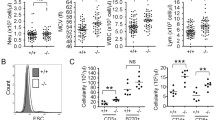Abstract
Using the method of gene transfection with liposome, we obtained the mouse erythroleukemia cell line MEL-TF19, which stably carries TFAR19, a novel apoptosis-related gene. The expression of TFAR19 was detected by Western blot. Growth curve and flow cytometry analysis showed that after being transfected with TFAR19 gene, the growth of MEL-TF19 is suppressed and its apoptosis is accelerated because of the serum deprivation. Our biorheological study indicated that in the apoptotic process, compared with MEL cells, MEL-TF19 cells exhibit larger osmotic fragility, lower cell surface charge density, increased elastic modulus K 1 which is inversely proportional to cells’ maximal deformation ability, obviously diminished surface viscosity μ, with elastic modulus K 2having no distinct changes. The above results provided some bases for recognizing the function of TFAR19 completely from the viewpoint of biorheology.
Similar content being viewed by others
References
Liu, H. T., Wang, Y. G., Zhang, Y. M. et al., TFAR19, a novel apoptosis-related gene cloned from human leukemia cell line TF-1, could enhance apoptosis of some tumor cells induced by growth factor withdrawl, Biochem. Biophy. Res. Commun., 1999, 254: 203–210.
Lin, K. Ch., Wu, B. J., Medical Biophysics (in Chinese), 1st ed., Beijing: United Publishing Company of Beijing Medical University and Concord University, 1996, 130.
Wu, Z. Zh., Zhang, G., Long, M. et al., Comparison of the viscoelastic properties of normal hepatocytes and hepatocellular carcinoma cells under cytoskeletal perturbation, Biorheology, 2000, 37: 279–290.
Long, M., Wu, Z. Z., Wang, H. B. et al., Study on hepatocyte viscoelasticity, Acta Biophysica Sinica, 1996, 12(3): 169–173.
Schmid-Schonbein, G. W., Sung, K. L. P., Tozeren, H. et al., Passive mechanical properties of human leukocytes, Biophys. J., 1981, 36: 243–256.
Zhang, Z. N., Pan, H. Z., Cell apoptosis and hematopathy, Chinese Journal of Hematology (in Chinese), 1996, 17(5): 267–270.
Jiao, J. F., Chen, G. Y., Huang, M. et al., Effect of rhTFAR19 protein on MCF-7 cell cycle and apoptosis induced by γ rays, Chinese Journal of Oncology, 2000, 22(2): 102–104.
Li, H. P., Cao, Z. M., Shao, Y. X. et al., Effect of rhTFAR.19 protein on cell apoptosis of 7721 liver cancer cells induced by hydroxy camptothecin, Journal of Beijing Medical University (in Chinese), 2000, 32(5): 408–410.
Zhang, Y. M., Xu, X. Z., Liu, H. T. et al., The apoptosis-accelerating effect of human recombinant TFAR19 protein on leukemia HL-60 cells, Chinese Journal of Immunology (in Chinese), 2000, 16(1): 8–11.
Wen, Z. Y., Song, L. C., Yan, Z. Y. et al., An animal model to study erythrocyte senescence with a narrow time window: Alterations in osmotic fragility and deformability of erythrocytes during their life span, Clinical Hemorhology and Microcirculation, 1998, 18(4): 299–306.
Wen, Z. Y., Song, L. C., Yan, Z. Y. et al., An animal model to study erythrocyte senescence with a narrow time window of erythrocyte production, Clinical Hemorhology and Microcirculation, 1998, 18(1): 75–84.
Xie, L. D., Sun, D. G., Yao, W. J. et al., Microrheological characteristics of reticulocyte in vivo, Science in China, Ser. C, 2002, 45(1): 50–56.
Author information
Authors and Affiliations
Corresponding author
Rights and permissions
About this article
Cite this article
Gu, L., Yao, W., Yan, Z. et al. Effects of TFAR19 gene on the growth and biorheological properties of mouse erythroleukemia cell line MEL. Sci. China Ser. C.-Life Sci. 46, 293–301 (2003). https://doi.org/10.1360/03yc9031
Received:
Issue Date:
DOI: https://doi.org/10.1360/03yc9031




